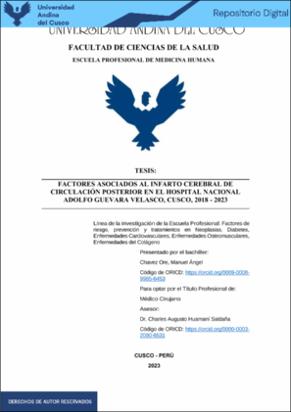| dc.contributor.advisor | Huamaní Saldaña, Charles Augusto | |
| dc.contributor.author | Chavez Ore, Manuel Ángel | |
| dc.date.accessioned | 2024-02-19T19:25:22Z | |
| dc.date.available | 2024-02-19T19:25:22Z | |
| dc.date.issued | 2023-12-12 | |
| dc.identifier.uri | https://hdl.handle.net/20.500.12557/6078 | |
| dc.description.abstract | Antecedentes: Los infartos cerebrales son causantes de altas tasas de morbimortalidad y
discapacidad; por ende, existen factores y etiologías bien estudiados para mejorar su tratamiento,
lamentablemente la data se basa en infartos de circulación anterior. Lamentablemente existe
información muy limitada sobre los factores asociados a los infartos de circulación posterior, por
tal es indispensable identificar los factores asociados. Objetivo: Determinar los principales
factores asociados al desarrollo de un infarto cerebral de circulación posterior en pacientes del
Hospital Nacional Adolfo Guevara Velasco, periodo 2018 -2023. Método: Es un estudio de tipo
observacional, analítico y transversal. Se determinaron los factores a medir según la bibliografía
ya sean (signos y síntomas, Hipertensión arterial, Fibrilación auricular, entre otras). Dentro de los
criterios de inclusión se tomaron en cuenta todo paciente que haya sufrido un infarto dentro del
periodo de estudio, que hayan sido corroborados por TAC o RM. Resultados: Se obtuvo un total
de 478 pacientes, de los cuales 200 desarrollaron infartos de circulación posterior. Los principales
factores relacionados con el desarrollo de un infarto de circulación posterior son; el Nistagmos
(OR: 30.77 IC 95% 10.96 - 86.34), Alteraciones de campos visuales (OR: 12.05 IC 95% 5.010 -
28.98), Ataxia (OR: 9.51 IC 95% 5.94 - 15.21), Vértigo o mareo (OR: 7.04 IC 95%: 4.40 - 11.26).
La hipertensión arterial (OR: 0.57 IC 95% 0.39 - 0.83) y fibrilación auricular (OR: 0.48 IC 95%
0.30 - 0.77). Fueron factores con menor probabilidad para el desarrollo de infartos de circulación
posterior. Conclusiones: Se determino que los principales factores asociados a los infartos de
circulación posterior fueron los signos y síntomas como el nistagmos, vértigo, ataxia, entre otros.
No siendo así con los antecedentes como la hipertensión arterial y fibrilación auricular; teniendo
menor probabilidad para desarrollar infartos posteriores. | es_PE |
| dc.description.abstract | Background: Cerebral infarctions cause high rates of morbidity, mortality, and disability;
Therefore, there are well-studied factors and etiologies to improve its treatment; unfortunately,
the data is based on anterior circulation infarctions. Unfortunately, there is very limited
information on the factors associated with posterior circulation infarctions, therefore it is essential
to identify the associated factors. Objective: Determine the main factors associated with the
development of a posterior circulation cerebral infarction in patients at the Adolfo Guevara
Velasco National Hospital, period 2018 -2023. Method: It is an observational, analytical, and
cross-sectional study. The factors to be measured were determined according to the literature
(signs and symptoms, arterial hypertension, atrial fibrillation, among others). Within the inclusion
criteria, any patient who had suffered a heart attack within the study period, which had been
corroborated by CT or MRI, was considered. Results: A total of 478 patients were obtained, of
which 200 developed posterior circulation infarctions. The main factors related to the
development of a posterior circulation infarction are Nystagmus (OR: 30.77 95% CI 10.96 -
86.34), Visual field alterations (OR: 12.05 95% CI 5.010 - 28.98), Ataxia (OR: 9.51 95% CI 5.94
- 15.21), Vertigo or dizziness (OR: 7.04 95% CI: 4.40 - 11.26). High blood pressure (OR: 0.57
95% CI 0.39 - 0.83) and atrial fibrillation (OR: 0.48 95% CI 0.30 - 0.77). They were factors with
a lower probability of developing subsequent heart attacks. Conclusions: It was determined that
the main factors associated with posterior circulation infarctions were signs and symptoms such
as nystagmus, vertigo, ataxia, among others. This is not the case with antecedents such as high
blood pressure and atrial fibrillation, having a lower probability of developing subsequent heart
attacks. | en_US |
| dc.format | application/pdf | es_PE |
| dc.language.iso | spa | es_PE |
| dc.publisher | Universidad Andina del Cusco | es_PE |
| dc.rights | info:eu-repo/semantics/openAccess | es_PE |
| dc.rights.uri | https://creativecommons.org/licenses/by-nc-nd/4.0/ | es_PE |
| dc.subject | Infarto cerebral | es_PE |
| dc.subject | Circulación posterior | es_PE |
| dc.subject | Factores de riesgo | es_PE |
| dc.title | Factores asociados al infarto cerebral de circulación posterior en el Hospital Nacional Adolfo Guevara Velasco, Cusco, 2018 - 2023 | es_PE |
| dc.type | info:eu-repo/semantics/bachelorThesis | es_PE |
| thesis.degree.name | Médico Cirujano | es_PE |
| thesis.degree.grantor | Universidad Andina del Cusco. Facultad de Ciencias de la Salud | es_PE |
| thesis.degree.discipline | Medicina Humana | es_PE |
| dc.publisher.country | PE | es_PE |
| dc.subject.ocde | https://purl.org/pe-repo/ocde/ford#3.00.00 | es_PE |
| renati.advisor.dni | 42357718 | |
| renati.advisor.orcid | https://orcid.org/0000-0003-2090-6531 | es_PE |
| renati.author.dni | 71477180 | |
| renati.discipline | 912016 | es_PE |
| renati.juror | Camero Frisancho, Miluska | |
| renati.juror | Chumbiraico Chumbimuni, Robert Luis | |
| renati.juror | Vignatti Valencia, Walter Justo | |
| renati.juror | Virto Concha, Carlos Alberto | |
| renati.level | https://purl.org/pe-repo/renati/level#tituloProfesional | es_PE |
| renati.type | https://purl.org/pe-repo/renati/type#tesis | es_PE |
| dc.description.lineadeinvestigacion | Factores de riesgo, prevención y tratamientos en Neoplasias, Diabetes, Enfermedades Cardiovasculares, Enfermedades Osteomusculares, Enfermedades del Colágeno | es_PE |




